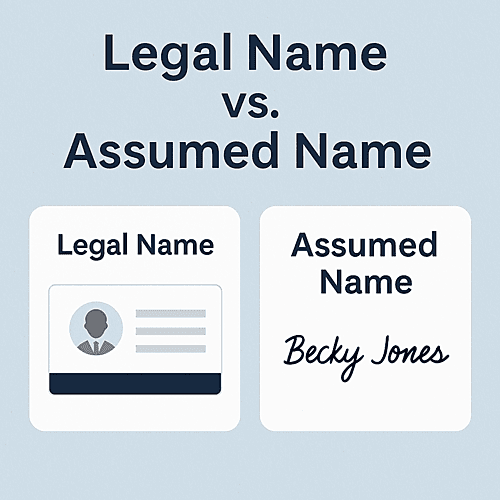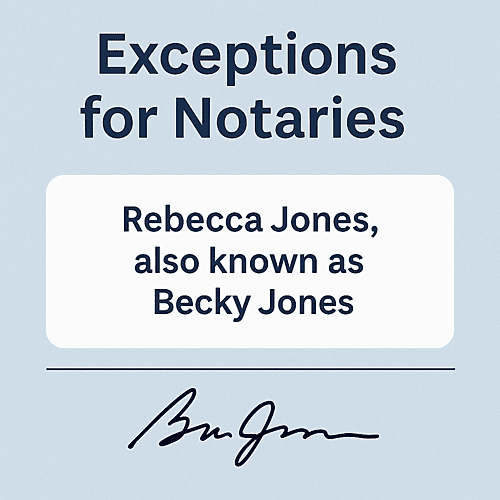Legal Name vs. Assumed Name in Notarizations: Why It Matters
As a Notary Public, you're not just a witness to signatures — you're a guardian of truth and identity. One common challenge we face is when signers attempt to use an assumed name or an alias instead of the legal name listed on their identification.
Let’s explore the key differences between these names, the rules around their use in notarizations, and how to protect your commission while educating your signers.

What is a Legal Name?
A legal name is the name listed on an individual's official government-issued identification, such as a driver's license or passport. This is the name notaries must rely on when confirming a signer's identity. It's the name that should be reflected on any document being notarized, unless otherwise structured with appropriate language.
What is an Assumed Name or Alias (AKA)?
An assumed name, sometimes called a "doing business as" (DBA) name or alias, is a name someone may use in personal or professional contexts. For example:
A signer named “Rebecca Jones” may go by “Becky Jones.”
A business owner named “James A. Smith” might sign as “Jim Smith” in day-to-day transactions.
People may also include "AKA" (Also Known As) to reference their alias on documents, such as:
“Rebecca Jones AKA Becky Jones”
Why This Matters in Notarizations
As a notary, you are required to confirm that the person signing the document is the same person identified on their ID. If a signer attempts to use a name that does not match their ID — even if it’s a commonly known nickname — this creates a red flag.
Using an assumed name without the proper structure in the document may:
Invalidate the notarization
Delay legal proceedings
Lead to accusations of fraud
Put your commission at risk
Exceptions & How to Handle “AKA” Situations
There are exceptions where a document may be correctly drafted to include both the legal name and assumed name. In these cases, the drafter may structure the signature line like:
“Rebecca Jones, also known as Becky Jones”
If the signer’s ID reflects “Rebecca Jones,” and the document clearly shows the alias, you may proceed — provided Rebecca Jones is the one signing and identified.
👉 Important: The notarial certificate must still reflect only the name on the identification presented, unless state law says otherwise.

What If the Document Only Shows the Assumed Name?
If the document is drafted using only the signer's assumed name — and that name does not appear anywhere on their ID — you may not proceed with the notarization.
This is a critical compliance checkpoint. The notary cannot verify a signer’s identity if the name on the document and the name on the ID do not align in some recognizable and documented way.
👉 Your Best Course of Action:
Kindly advise the signer to contact the document drafter or preparer and request one of the following:
A revised version of the document that includes both the legal name and the assumed name (e.g., “Rebecca Jones, also known as Becky Jones”), or
An additional statement or attachment that clearly connects the assumed name to the legal name, ideally signed and acknowledged by the appropriate authority
Without that clarity, you could unintentionally notarize a document that may be rejected or questioned — and that could place liability on you.
Educating the Signer
It’s essential to explain that a notary cannot notarize a document if the name signed does not match the ID presented. Encourage signers to:
Have documents correctly drafted with both names if necessary.
Avoid signing with a name not shown on their ID.
Consult with the receiving agency if they insist on using an alias.
Protecting Your Commission
Document the situation in your notary journal:
Note the name on the ID
Note any discrepancies or aliases on the document
Describe how the situation was resolved
This protects your notarial act and keeps a record in case questions arise later.
Final Thought from the CEO's Desk
Whether you’re notarizing a power of attorney, real estate documents, or an affidavit, clarity on the signer’s name is non-negotiable. A notary’s role is to uphold integrity in every transaction — and that begins with proper name verification.


